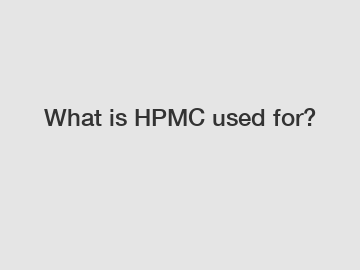What is HPMC used for?
What is HPMC used for?
HPMC, which stands for hydroxypropyl methyl cellulose, is a versatile substance that is widely used in various industries. In this article, we will explore the uses of HPMC, its origin, the process of its discovery, and its significance and impact.
HPMC is primarily used as a thickening, stabilizing, and film-forming agent in many different applications. One of its main uses is in the construction industry, where it is often added to cement-based materials to improve their workability, water retention, and adhesion. Additionally, HPMC is commonly employed in the production of coatings, paints, and adhesives due to its ability to enhance viscosity, improve adhesion, and provide high-quality film formation.

The origin of HPMC dates back to the early 20th century when scientists were exploring ways to modify and improve the properties of cellulose. Cellulose, a naturally occurring polymer found in the cell walls of plants, has excellent film-forming properties but lacks certain characteristics required for various applications. In the 1920s, researchers discovered that by adding propylene oxide to cellulose, they could create a modified cellulose compound with enhanced properties. This marked the birth of HPMC.
Over the years, the development of HPMC has undergone extensive research and innovation, leading to the creation of different grades and variations tailored for specific industries and applications. Today, HPMC is manufactured through a meticulous process that involves treating cellulose with alkaline substances, followed by reaction with methyl chloride and propylene oxide. This process results in the formation of a white powder that can be easily dissolved in water.
The significance of HPMC lies in its wide range of applications and the benefits it brings to various industries. In the construction industry, the addition of HPMC to cement-based materials improves the workability of the mixture, making it easier to handle and apply. It also enhances the water retention of the mixture, preventing premature drying and enabling better hydration of the cement. Moreover, the film-forming properties of HPMC contribute to improved adhesion and durability of coatings, paints, and adhesives.
The impact of HPMC on industries such as construction, coatings, paints, and adhesives cannot be understated. By using HPMC, manufacturers are able to produce high-quality products with improved performance characteristics. This leads to better outcomes for end-users, such as stronger and more durable building materials, long-lasting coatings, and reliable adhesives. Additionally, the use of HPMC often results in reduced environmental impact due to the lower levels of volatile organic compounds (VOCs) emitted from the finished products.
In conclusion, HPMC is a multi-purpose substance that finds applications in various industries. Its uses as a thickening, stabilizing, and film-forming agent make it indispensable in the construction industry, as well as in the production of coatings, paints, and adhesives. The discovery of HPMC and its subsequent development have revolutionized these industries by introducing improved performance characteristics and reducing environmental impact. With its wide range of applications and continued innovation, HPMC will continue to play a vital role in shaping the future of these industries.
If you are looking for more details, kindly visit HPMC for self-leveling mortar, HPMC for gypsum, HPMC for drymix mortar.

Comments
0